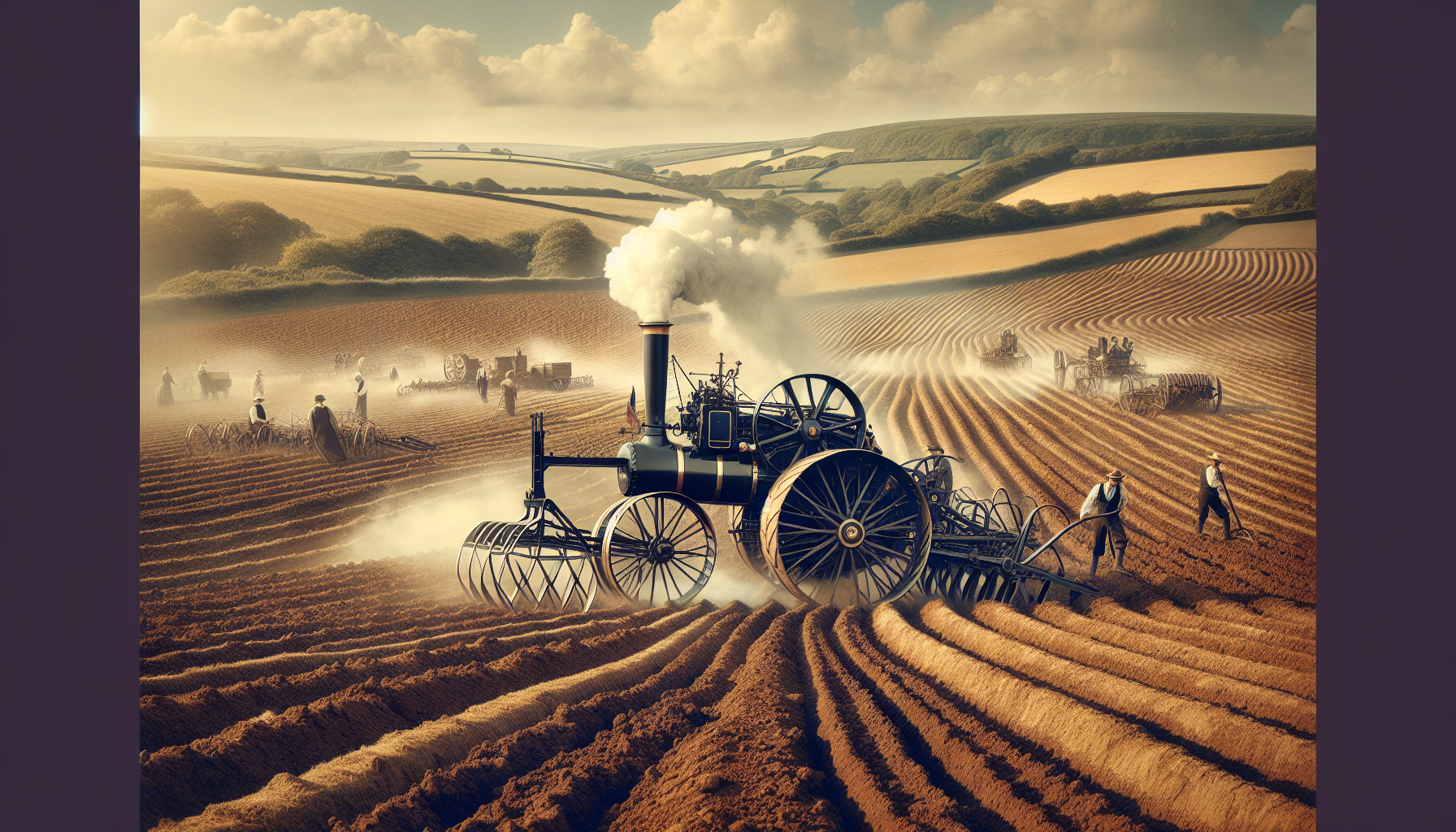In the vibrant tapestry of human history, few innovations have had as profound an impact on agriculture as the steam-powered plow. Imagine a time when the vast stretches of farmland were tilled by horse-drawn plows, a laborious process that limited the scope and scale of agricultural productivity. Now, envision a new dawn, where steam engines transform this landscape, ushering in an era of unparalleled efficiency and productivity. This is not just a story of technological advancement; it is a testament to human ingenuity and the relentless pursuit of progress. 🚜💨 As we embark on this exploration of steam-powered plows, we will uncover how this remarkable invention revolutionized agriculture, setting the stage for the modern farming practices we see today.
At the heart of this revolution was the steam engine, a marvel of 19th-century engineering that powered not only locomotives and factories but also farm equipment. The steam-powered plow represented a significant leap forward, allowing farmers to cultivate larger areas of land in a fraction of the time it once took. This innovation was pivotal in addressing the growing food demands of an ever-expanding population, and it laid the groundwork for subsequent advancements in agricultural machinery. In this blog post, we will delve into the origins of steam-powered plows, examining the technological breakthroughs that made them possible and the visionary individuals who championed their development. We will also explore the broader implications of this transformation, considering how it reshaped rural communities and the agricultural economy as a whole.
As we journey through this fascinating period in agricultural history, we will also address the challenges and limitations faced by early adopters of steam technology. While the benefits were undeniable, the transition from traditional to steam-powered farming was not without its hurdles. We will investigate the economic and logistical obstacles that farmers encountered and discuss the innovations that eventually overcame these challenges. Finally, we will reflect on the lasting legacy of steam-powered plows and how they set the stage for the technological marvels of modern agriculture. By the end of this article, you’ll have a deeper appreciation for how steam power not only revolutionized farming practices but also laid the foundation for a more efficient and productive agricultural future. 🌾
The Evolution of Agricultural Technology: From Manual Labor to Steam-Powered Plows
Agriculture has been the backbone of human civilization for thousands of years, continually evolving with the advancements in technology. The shift from manual labor to mechanized farming tools marked a significant leap in agricultural productivity. Among these innovations, the steam-powered plow stands out as a groundbreaking development that revolutionized farming practices in the 19th century. This mechanization not only increased the efficiency of farming operations but also played a critical role in transforming agriculture into a more sustainable and productive industry.
Steam power brought a remarkable change in the way farming was conducted. Before the advent of steam-powered plows, farmers relied heavily on human and animal labor to till the land. This method was not only time-consuming but also limited in scope, restricting the amount of land that could be cultivated. The introduction of steam engines changed this scenario drastically, enabling farmers to cover larger areas with greater speed and less effort. By harnessing the power of steam, farmers could plow fields that were previously considered too difficult or labor-intensive to cultivate, thus opening up new opportunities for agricultural expansion.
The innovation of steam-powered plows was not just about increasing the area of cultivation; it also enhanced the quality of the soil preparation. Steam plows allowed for deeper and more consistent tilling, improving soil aeration and water retention, which are crucial for crop growth. This innovation set the stage for further advancements in agricultural technology, paving the way for modern farming equipment that continues to build on the principles of efficiency and productivity introduced by steam power. To better understand the impact of steam-powered plows on agriculture, let’s dive deeper into their development, advantages, and the subsequent transformations in the farming industry.
Historical Context and Development of Steam-Powered Plows
The 19th century was a period of rapid industrialization and technological progress, setting the scene for the development of steam-powered machinery. The steam engine, initially invented by Thomas Newcomen in the early 1700s and later improved by James Watt, became the driving force behind various industrial applications, including agriculture. The adaptation of steam power to plowing was pioneered by inventors like John Fowler, who recognized the potential of steam engines to revolutionize traditional farming methods.
John Fowler, an English agricultural engineer, is often credited with the invention of the steam-powered plow in the mid-1800s. He introduced the concept of using a steam engine to pull a plow across the fields using a system of cables and winches. This method was a significant improvement over earlier attempts to use steam engines directly attached to plows, which were often cumbersome and inefficient. Fowler’s design allowed for greater flexibility and efficiency, enabling farmers to work on larger areas and tackle challenging terrains that were previously inaccessible.
The steam-powered plow became a symbol of technological progress in agriculture, reflecting the broader trend of mechanization that was sweeping across industries during the Industrial Revolution. This period saw a shift from agrarian economies reliant on manual labor to more industrialized systems that leveraged machines for increased productivity. The adoption of steam-powered plows was a crucial step in this transformation, demonstrating the potential of technology to enhance agricultural output and support the growing demands of an expanding population.
Advantages of Steam-Powered Plows in Modern Agriculture
The benefits of steam-powered plows extend far beyond their ability to cover large areas of land efficiently. These machines introduced several advantages that significantly enhanced agricultural practices, setting the foundation for modern farming techniques. One of the most notable benefits is the improvement in soil management. Steam-powered plows allowed for deeper tillage, which is essential for breaking up compacted soil layers and promoting better root penetration and nutrient uptake by crops.
Another advantage of steam-powered plows is their contribution to labor efficiency. By reducing the reliance on human and animal labor, these machines enabled farmers to allocate resources more effectively and focus on other critical aspects of farm management. This shift also reduced the physical burden on workers, improving overall working conditions and allowing for the cultivation of more extensive fields with the same or fewer labor resources.
Moreover, steam-powered plows facilitated the introduction of crop rotation and diversification practices, which are crucial for sustainable agriculture. By enabling the preparation of larger and more uniform fields, farmers could experiment with different crops and planting schedules, improving soil health and reducing the risk of pest and disease outbreaks. This flexibility was instrumental in increasing agricultural output and supporting food security in an era of rapid population growth. To visualize the advantages of steam-powered plows compared to traditional methods, take a look at the table below.
| Aspect | Manual Labor | Steam-Powered Plows |
|---|---|---|
| Efficiency | Low | High |
| Labor Intensity | High | Low |
| Area Coverage | Limited | Extensive |
| Soil Quality | Variable | Consistent |
Transformations in Farming Practices
The introduction of steam-powered plows marked a turning point in farming practices, encouraging farmers to adopt more innovative and efficient techniques. As these machines became more widespread, they paved the way for a host of other technological advancements that continued to reshape the agricultural landscape. The use of steam-powered machinery led to the development of more sophisticated farming equipment, including tractors and combine harvesters, which further enhanced productivity and efficiency.
One of the key transformations driven by steam-powered plows was the shift towards monoculture farming. The ability to cultivate larger areas with ease encouraged farmers to focus on a single crop, maximizing output and efficiency. This approach, while beneficial in terms of yield, also highlighted the importance of sustainable farming practices to maintain soil health and biodiversity. Farmers began to explore techniques such as crop rotation and intercropping to balance the demands of monoculture with the need for sustainable land management.
Challenges and Considerations in Implementing Steam-Powered Plows
While the advantages of steam-powered plows are numerous, their implementation was not without challenges. One of the primary obstacles was the cost associated with acquiring and maintaining these machines. Steam engines and plows required significant financial investment, which was often beyond the reach of small-scale farmers. This limitation led to the concentration of mechanized farming in the hands of wealthier landowners and larger agricultural enterprises, contributing to economic disparities within rural communities.
Another challenge was the need for skilled operators to manage and maintain the steam-powered equipment. Unlike traditional farming methods that relied on readily available labor, operating a steam-powered plow required specialized knowledge and training. This requirement created a demand for skilled workers and highlighted the importance of education and training programs in supporting the transition to mechanized farming. Additionally, the maintenance and repair of steam engines were complex tasks that required access to technical expertise and resources, posing a barrier for some farmers.
Environmental considerations also played a role in the adoption of steam-powered plows. The use of steam engines, which relied on coal or wood as fuel, raised concerns about environmental impact and resource sustainability. As the agricultural industry continued to evolve, these considerations became increasingly important, leading to the development of more environmentally friendly technologies and practices. Today, the legacy of steam-powered plows is reflected in the ongoing efforts to balance productivity with environmental stewardship in agriculture.
Modern Reflections and Future Directions
In the modern agricultural landscape, the influence of steam-powered plows is still evident in the principles of mechanization and efficiency that drive the industry. Today’s farmers benefit from a wide range of advanced machinery and technologies that build on the foundations laid by early innovations like the steam-powered plow. The challenges faced by these early machines have informed the development of more sustainable and accessible technologies, ensuring that the benefits of mechanization are available to farmers of all scales.
Looking to the future, the lessons learned from the era of steam-powered plows continue to guide the evolution of agricultural technology. As the world faces new challenges such as climate change, food security, and resource management, the agricultural industry must continue to innovate and adapt. The principles of efficiency and productivity that defined the steam-powered era remain relevant, driving the development of cutting-edge solutions that will shape the future of farming.
To explore more about the impact of steam-powered plows on agriculture, check out the video below for a visual overview of their role in transforming farming practices:
The Power of Steam in Agriculture – Farming History Channel

Conclusion
In conclusion, the exploration of steam-powered plows marks a pivotal chapter in the history of agricultural innovation, emphasizing the transformative potential of technology to drive productivity and efficiency in farming practices. This article delved into the historical context of steam technology, its application in agriculture, and the profound impact it has had on shaping modern farming techniques.
Initially, we explored the evolution of steam technology and how its introduction into agriculture signaled the dawn of a new era. Steam-powered plows represented a significant leap from traditional manual and animal-powered methods, offering a robust solution that enhanced the scale and speed of plowing. This innovation not only improved the efficiency of land preparation but also laid the groundwork for subsequent technological advancements in farming equipment.
We then examined the specific advantages of steam-powered plows, highlighting their ability to cover larger areas in less time and with greater precision. This efficiency led to increased crop yields, reduced labor costs, and the ability to cultivate previously challenging terrains. The ripple effect of these improvements contributed significantly to the agricultural boom, supporting the growing demands of the industrial era.
The discussion also touched on the environmental and economic implications of integrating steam technology in agriculture. While the initial cost of adopting steam-powered machinery was considerable, the long-term benefits in terms of productivity and sustainability were undeniable. By reducing reliance on animal labor and optimizing land use, steam technology paved the way for more sustainable agricultural practices, albeit with an awareness of the environmental considerations inherent to steam engines.
Furthermore, we addressed the socio-economic impact, acknowledging how steam-powered plows revolutionized rural economies by creating jobs, fostering skills development, and enabling farmers to scale operations. This technological shift played a crucial role in transforming agriculture into a viable economic sector, capable of supporting large populations and contributing to global food security.
As we reflect on the journey of steam-powered plows, it’s evident that this innovation was more than just a technological advancement; it was a catalyst for change that redefined agricultural norms and possibilities. The legacy of steam technology continues to inspire modern advancements in agricultural machinery, reminding us of the importance of embracing innovation to meet the ever-evolving challenges of food production.
The importance of understanding and appreciating this historical evolution cannot be overstated. By recognizing the milestones of past innovations, we equip ourselves with the knowledge and inspiration needed to tackle current and future challenges in agriculture. The lessons learned from the integration of steam technology into farming are as relevant today as they were in the past, providing valuable insights into the potential of technology to drive sustainable development.
In light of the discussions presented, we encourage readers to consider the broader implications of technological advancements in agriculture. Whether you are a farmer, an innovator, or simply an enthusiast, the story of steam-powered plows offers valuable lessons in creativity, resilience, and the pursuit of progress. By sharing this knowledge and fostering discussions, we can collectively contribute to a more sustainable and efficient agricultural future.
For further reading and exploration, you might consider visiting resources like Smithsonian’s History of Agriculture, The Agricultural History Society, or The Steam Engine Library to delve deeper into the fascinating world of agricultural innovations.
As we move forward, let us remain inspired by the pioneers of steam technology and commit to fostering a spirit of innovation that will sustain and nourish our global community. Together, we can unleash efficiency and revolutionize agriculture for maximum productivity, ensuring a brighter future for all. 🌟
Toni Santos is a visual historian and creative artisan whose work channels the bold spirit of the steam-powered era—a time when imagination, mechanics, and ambition converged to reshape the modern world. Through richly detailed visual narratives and handcrafted design, Toni celebrates the legacy of steam innovation as both an artistic and technological revolution.
Driven by a passion for mechanical aesthetics, forgotten inventions, and industrial-age ingenuity, Toni reimagines the world of steam through illustrations, tactile artifacts, and storytelling that capture the poetry of pressure, motion, and invention. From piston-driven engines to brass-detailed diagrams, each piece reveals how steam wasn’t just power—it was promise.
With a background in visual design and historical research, Toni brings a craftsman’s eye and a dreamer’s heart to the stories of tinkerers, inventors, and visionaries who shaped the 19th century. His work doesn’t merely document machines—it honors the culture, courage, and creativity that drove a world to reimagine itself through gears, valves, and vapor.
As the creative voice behind Vizovex, Toni shares curated articles, reconstructed blueprints, and visual interpretations that bring this industrial past to life. His collections serve as a tribute to:
The elegance of steam-era design and innovation
The human stories behind great mechanical feats
The aesthetic beauty found in function and form
The echo of invention in today’s creative world
Whether you’re a history lover, a fan of steampunk, or an admirer of antique technology, Toni welcomes you into a world where art and machinery fuse, one cog, one drawing, one rediscovered marvel at a time.





